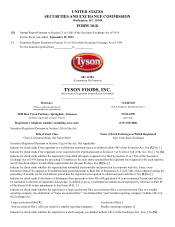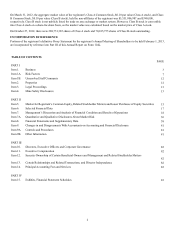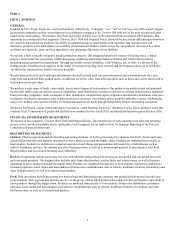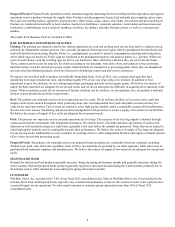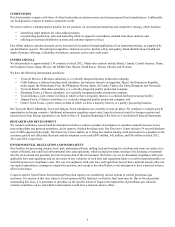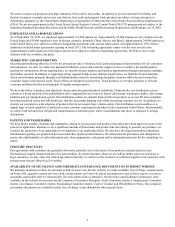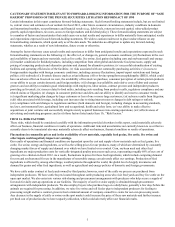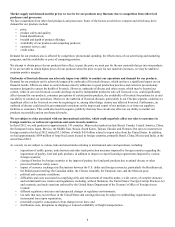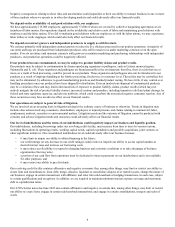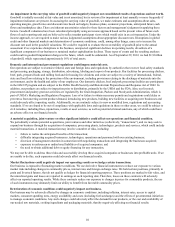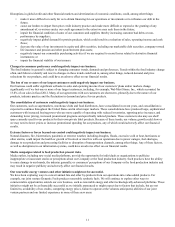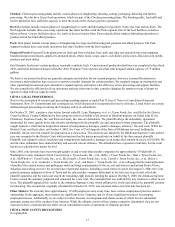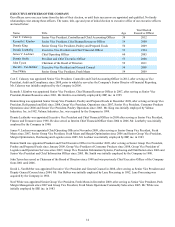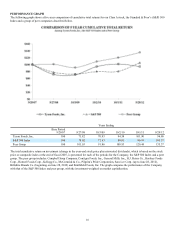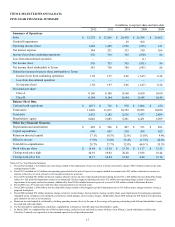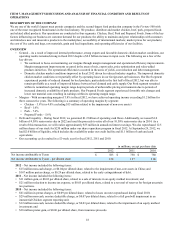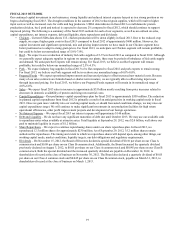Tyson Foods 2012 Annual Report Download - page 9
Download and view the complete annual report
Please find page 9 of the 2012 Tyson Foods annual report below. You can navigate through the pages in the report by either clicking on the pages listed below, or by using the keyword search tool below to find specific information within the annual report.9
Negative consequences relating to these risks and uncertainties could jeopardize or limit our ability to transact business in one or more
of those markets where we operate or in other developing markets and could adversely affect our financial results.
We depend on the availability of, and good relations with, our employees.
We have approximately 115,000 employees, approximately 37,000 of whom are covered by collective bargaining agreements or are
members of labor unions. Our operations depend on the availability and relative costs of labor and maintaining good relations with
employees and the labor unions. If we fail to maintain good relations with our employees or with the labor unions, we may experience
labor strikes or work stoppages, which could adversely affect our financial results.
We depend on contract growers and independent producers to supply us with livestock.
We contract primarily with independent contract growers to raise the live chickens processed in our poultry operations. A majority of
our cattle and hogs are purchased from independent producers who sell livestock to us under marketing contracts or on the open
market. If we do not attract and maintain contracts with growers or maintain marketing and purchasing relationships with independent
producers, our production operations could be negatively affected.
If our products become contaminated, we may be subject to product liability claims and product recalls.
Our products may be subject to contamination by disease-producing organisms or pathogens, such as Listeria monocytogenes,
Salmonella and E. coli. These organisms and pathogens are found generally in the environment; therefore, there is a risk that one or
more, as a result of food processing, could be present in our products. These organisms and pathogens also can be introduced to our
products as a result of improper handling at the further processing, foodservice or consumer level. These risks may be controlled, but
may not be eliminated, by adherence to good manufacturing practices and finished product testing. We have little, if any, control over
handling procedures once our products have been shipped for distribution. Even an inadvertent shipment of contaminated products
may be a violation of law and may lead to increased risk of exposure to product liability claims, product recalls (which may not
entirely mitigate the risk of product liability claims), increased scrutiny and penalties, including injunctive relief and plant closings, by
federal and state regulatory agencies, and adverse publicity, which could exacerbate the associated negative consumer reaction. Any of
these occurrences may have an adverse effect on our financial results.
Our operations are subject to general risks of litigation.
We are involved on an on-going basis in litigation arising in the ordinary course of business or otherwise. Trends in litigation may
include class actions involving consumers, shareholders, employees or injured persons, and claims relating to commercial, labor,
employment, antitrust, securities or environmental matters. Litigation trends and the outcome of litigation cannot be predicted with
certainty and adverse litigation trends and outcomes could adversely affect our financial results.
Our level of indebtedness and the terms of our indebtedness could negatively impact our business and liquidity position.
Our indebtedness, including borrowings under our revolving credit facility, may increase from time to time for various reasons,
including fluctuations in operating results, working capital needs, capital expenditures and possible acquisitions, joint ventures or
other significant initiatives. Our consolidated indebtedness level could adversely affect our business because:
• it may limit or impair our ability to obtain financing in the future;
• our credit ratings (or any decrease to our credit ratings) could restrict or impede our ability to access capital markets at
desired interest rates and increase our borrowing costs;
• it may reduce our flexibility to respond to changing business and economic conditions or to take advantage of business
opportunities that may arise;
• a portion of our cash flow from operations must be dedicated to interest payments on our indebtedness and is not available
for other purposes; and
• it may restrict our ability to pay dividends.
Our revolving credit facility contains affirmative and negative covenants that, among other things, may limit or restrict our ability to:
create liens and encumbrances; incur debt; merge, dissolve, liquidate or consolidate; dispose of or transfer assets; change the nature of
our business; engage in certain transactions with affiliates; and enter into sale/leaseback or hedging transactions, in each case, subject
to certain qualifications and exceptions. In addition, we are required to maintain minimum interest expense coverage and maximum
debt to capitalization ratios.
Our 4.50% Senior notes due June 2022 also contain affirmative and negative covenants that, among other things, may limit or restrict
our ability to: create liens; engage in certain sale/leaseback transactions; and engage in certain consolidations, mergers and sales of
assets.

